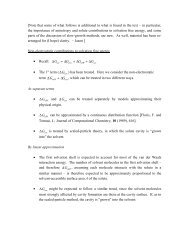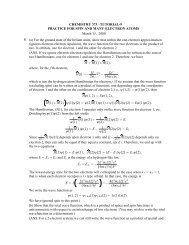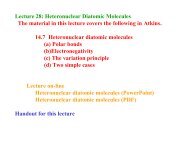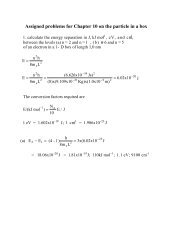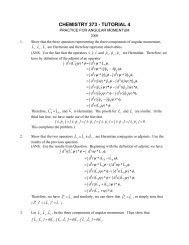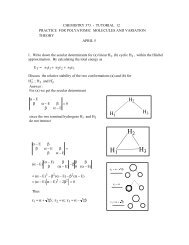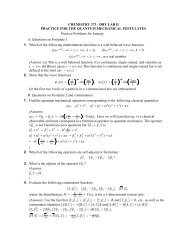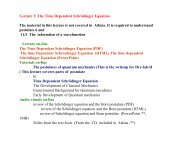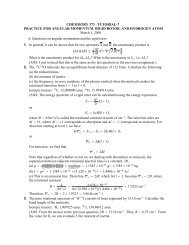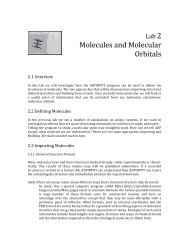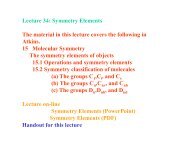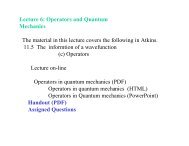CHEMISTRY 373 –TUTORIAL 8 PRACTICE FOR ... - Cobalt
CHEMISTRY 373 –TUTORIAL 8 PRACTICE FOR ... - Cobalt
CHEMISTRY 373 –TUTORIAL 8 PRACTICE FOR ... - Cobalt
Create successful ePaper yourself
Turn your PDF publications into a flip-book with our unique Google optimized e-Paper software.
<strong>CHEMISTRY</strong> <strong>373</strong> <strong>–TUTORIAL</strong> 8<br />
<strong>PRACTICE</strong> <strong>FOR</strong> HYDROGEN ATOM AND ELECTRON SPIN<br />
March 8, 2000<br />
1. Draw contour plots of the 3d orbitals of hydrogen and place the signs on the orbitals. (These are<br />
meant to be sketches not the precise contour plots.)<br />
2. Discuss the differences between radial densities and the contour plots for the hydrogen 3s and<br />
3p orbitals. When you draw contour diagrams for the 3s and 3p orbitals do the radial nodes<br />
affect the signs that you place on the orbital lobes?<br />
3. What is the average distance of the electron from the nucleus in a 2s and a 2p orbital for (a) H,<br />
and (b) Li 2+ ?<br />
(ANS. The normalized wave function for an electron in a 2s orbital for a H-like species is<br />
1<br />
f 2,0,0 = Z 2<br />
Ý2 ? _Þe ?_/2 Y<br />
8<br />
0,0 ÝS,jÞ,<br />
where _ = Zr/a 0 (See Table 13.1 in Atkins). The average distance of the electron in this state<br />
from the nucleus is<br />
a 0<br />
3<br />
K<br />
Ör× 2s = X r 2 2^<br />
0<br />
drX<br />
0^<br />
sinSdSX<br />
D djf2,0,0 rf 2,0,0 ,<br />
0<br />
= 1 8<br />
= 1 8<br />
Z<br />
a 0<br />
3<br />
X<br />
0<br />
K<br />
r 3 drÝ2 ? _Þ 2 e ?_ X<br />
0^<br />
sinSdSX<br />
0<br />
2^<br />
djY0,0 ÝS,jÞ D Y 0,0 ÝS,jÞ,<br />
3<br />
Z a 0<br />
a 0 Z<br />
a 0<br />
4<br />
X<br />
0<br />
K<br />
d__ 3 Ý2 ? _Þ 2 e ?_ ,<br />
= 1 K<br />
8<br />
X d_Ý_<br />
Z 5 ? 4_ 4 + 4_ 3 Þe ?_ ,<br />
0<br />
= 1 a 0<br />
Ý5! ? 4 × 4! + 4 × 3!Þ,<br />
8 Z<br />
= 6 a 0<br />
Z ,<br />
where we have used the fact that the spherical harmonics are normalized and the integral<br />
K<br />
X d__ n e ?_ = n!. For a 2p state, select the 2p z = 2p 0 = f 2,1,0 wave function<br />
0<br />
f 2,1,0 = 1<br />
3<br />
Z 2<br />
2 6 a 0<br />
_e ?_/2 Y 1,0 ÝS,jÞ.<br />
The expectation value or average value of the distance is<br />
K<br />
Ör× 2p = X r 2 2^<br />
0<br />
drX<br />
0^<br />
sinSdSX<br />
D djf2,1,0 rf 2,1,0 ,<br />
0<br />
= 1 24<br />
a 0<br />
Z<br />
K<br />
X _ 5 e ?_ ,<br />
0<br />
= 5! 1 a 0<br />
24 Z<br />
,<br />
= 5 a 0<br />
Z<br />
.<br />
(a) For H, Z = 1, and Ör× 2s = 6a 0 , and Ör× 2p = 5a 0 . (b) For Li 2+ , Z = 3 and Ör× 2s = 2a 0 and<br />
Ör× 2p = 5 a 3 0.)<br />
4. What is the magnitude of the angular momentum for an electron in a 3p orbital in hydrogen?<br />
How many radial and angular nodes does the 3p wave function have?<br />
(ANS. For a 3p state, l = 1 and the wave function can be written f 3,1,0 . Hence,<br />
å2 L f2,1,0 = 2¥ 2 f 3,1,0 . Therefore, the magnitude of the total orbital angular momentum is 2 ¥.<br />
There are n ? 1 nodes in all, l angular nodes and n ? l ? 1 radial nodes. For the 3p state there are
2 nodes in total, 1 angular node and 1 radial node.)<br />
5. Show that the real 2p x and 2p y orbitals are not eigenfunctions of the å L z operator.<br />
(ANS.The real 2p x and 2p y functions can be expressed in terms of the complex functions as<br />
follows:<br />
Therefore, we find that<br />
Similarly, we see that<br />
f 2px =<br />
1<br />
2 Ýf 2,1,?1 ? f 2,1,1Þ, f 2py = i<br />
1<br />
2 Ýf 2,1,?1 + f 2,1,1Þ.<br />
å<br />
Lz f 2px =<br />
1<br />
2<br />
å<br />
Lz f 2,1,?1 ? å L z f 2,1,1 ,<br />
= ?¥ 1 2 Ýf 2,1,?1 + f 2,1,1Þ,<br />
= i¥f 2py .<br />
å<br />
Lz f 2py = i<br />
1<br />
2<br />
å<br />
Lz f 2,1,?1 + å L z f 2,1,1 ,<br />
= i¥ 1 2 Ý?f 2,1,?1 + f 2,1,1Þ,<br />
= ?i¥f 2px .<br />
From these equations, we see that the real 2p orbitals, 2p x and 2p y , are not eigenfunctions of the<br />
å<br />
Lz operator.)<br />
6. (a) If the spin component S z of an electron is measured, what possible values can result?<br />
(ANS. + 1 2 ¥ and ? 1 2 ¥.)<br />
(b) The set of common eigenfunctions of å S 2 and å S z are denoted by J = f 1<br />
2 , 1 2<br />
Show that<br />
å S x J = 1 ¥K, å<br />
2 S x K = 1 ¥J, 2<br />
and K = f 1<br />
2 ,? 1 .<br />
2<br />
å S y J = 1 2 i¥K,<br />
å S y K = ? 1 2 i¥J.<br />
(ANS: Write å S x = 1 2 Ýå S ? + å S + Þ and å S y = i 2 Ýå S ? ? å S + Þ. The rest follows from å S + J = 0,<br />
å S + K = ¥J, å S ? J = ¥K, å S ? K = 0.)<br />
7. (c) If the spin component S x of an electron is measured, what possible values can result?<br />
(ANS. According to Postulate 3, what will be measured are the eigenvalues of the operator å S x .<br />
Let e be an eigenfuction of å S x with eigenvalue V. Thus,<br />
å S x e = Ve.<br />
Since the eigenfunctions J and K of the spin operator å S z form a complete set (Postulate 4), we<br />
can express e as a linear combination of J and K:<br />
e = aJ + bK.<br />
Using the results from part (b), we have<br />
å S x e = 1 Ýå S<br />
2 ? + å S + ÞÝaJ + bKÞ,<br />
This implies that<br />
= ¥ 2 bJ + ¥ 2 aK,<br />
= VaJ + VbK.<br />
Va = ¥ 2 b, Vb = ¥ 2 a.
Using the second to substitute for b in the first equation, we obtain<br />
or<br />
V 2 = ¥2<br />
4 ,<br />
V = ± ¥ 2 .<br />
Therefore, we would measure ±¥/2 for S x .)<br />
(d) According to Postulate 4, the spin functions, J and K, form a complete set. This means that<br />
any one-electron spin function can be written as a linear combination of J and K. Construct<br />
eigenfunctions of å S x having the eigenvalues obtained in (c).<br />
(ANS. From Part (c), suppose that V = +¥/2. Then, a = b and we write<br />
e+ ÝxÞ = aÝJ + KÞ.<br />
We fix a by normalization, i.e., a = 1/ 2 . If V = ?¥/2, then b = ?a and we have<br />
e ? ÝxÞ = aÝJ ? KÞ.<br />
Again, fix a by normalization. The final result is<br />
Confirm that<br />
e+ ÝxÞ =<br />
1<br />
2 ÝJ + KÞ, e ? ÝxÞ =<br />
1<br />
2<br />
S x e ± ÝxÞ = ± ¥ 2 e ± ÝxÞ .<br />
ÝJ ? KÞ.<br />
That completes the analysis.)<br />
(e) Suppose a measurement of S z is carried out and a value of + 1 ¥is obtained. If a measurement<br />
2<br />
of S x is then carried out, give the probabilities for each outcome.<br />
(ANS. If S z is measured and a value of + 1 ¥ is measured, then the particle will be in the state J.<br />
2<br />
If the property S x is measured then either the eigenvalue + 1 ¥ or ? 1 ¥ will be obtained with<br />
2 2<br />
probability X db J D e+ ÝxÞ 2<br />
=<br />
1<br />
or X db 2 JD ÝxÞ<br />
2<br />
e ? =<br />
1<br />
, respectively.)<br />
2<br />
8. Show that J and K are each eigenfunctions of å S x<br />
2<br />
but not<br />
å S x .<br />
(ANS. From Part (b), we have already seen that J and K are not eigenfunctions of å S x .<br />
Furthermore, we have<br />
å S x<br />
2<br />
J =<br />
1<br />
2 ¥å S x K = 1 4 ¥2 J,<br />
å S x<br />
2<br />
K =<br />
1<br />
2 ¥S xJ = 1 4 ¥2 K,<br />
where we have used the identities in Part (b).)



